OK here goes, it's made from 25mm MDF, first, rip the sheet in equal half across its width this gives you two pieces roughly 1.2m square turn one end over by folding end – end lengthways and square up and line up the two machined cut edge’s. Be careful 25mm MDF is extremely heavy.
First, measure in 600mm from left-hand machine edge along the front edge and repeat along the top edge and mark a pencil line, now repeat 600mm up the left and right-hand sides and mark a line, you have now divided the sheet into four 600 mm squares. This is then giving you the common centre point where the lines cross each other.
Next measure the footprint of the base of your saw. mine was 540mm across the front * 680mm in depth if my memory is correct, (adjust measurements for your own saw size), so now half these measurements, starting from your vertical centre line at the common centre point where the lines cross mark up 340mm and down 340mm and on the horizontal line mark 270 mm in both direction from the centre line, when the line is drawn in, this gives me the footprint size of my saw.
On my saw, I have four feet 100mm Square * 30mm wide (L shaped) if you have something similar draw these onto the board as well (it’s important later) OK once you have done that you need a large compass or a set of trammels, measure about 25mm inside the inner edge of the four feet by about 25mm set trammels or compass and draw your first circle this is the first groove for your ball bearings now do the same about 60mm outside the corner of the feet and mark the second circle (second groove for ball bearings), this now places your saw directly between the two grooves which will displace the weight evenly between the two ball bearing runs, right now strike you outer finish circumference from a centre common point - to the left-hand edge of the 1.2m square sheet and mark the circle, It’s important to do this I cut my circumference on the band saw, it’s so simple, honest.
CUTTING THE CIRCLE.
Now whilst both sheets are still together depending on what size dowel rod you have drill a hole of the same diameter through both the sheets at the common centre point, this hole will first be used as the centre swivel point whilst cutting the out diameter on the band saw and whilst routing out your grooves for the ball bearings also now whilst the new circular base is still at the band saw remove the surplus offcuts from around it, (cut one sheet at a time NOT both together as they are much too heavy to handle for safety reason) when both circles have been cut the centre common point will need to be drilled larger 12.7 mm or there a bout’s to accommodate the bolt to bolt the two section together which you’ll need to chop the hexagon head flush into the underside surface before the lower circle is secured to workshop floor first before final assemble.
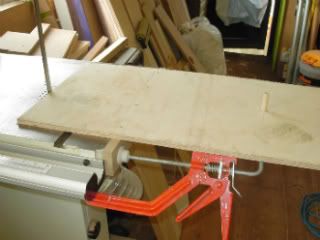 MAKING THE JIGS TO CUT THE CIRCLES
MAKING THE JIGS TO CUT THE CIRCLES You’ll only need scrap timber don’t use anything expensive. Find something wide enough to balance a half sheet of 25mm MDF on it only need to be about 300mm. I think at this time I let the picture explain how it’s done quite simple really. Jig clamped to band-saw. Photo showing centre swivel pin. That’s your first jig done.
OK, all I can show you here because I didn’t take any photos of the circle being cut but what I can show is the waste material left in a position which I think you’ll get the idea how it is done, with the half sheet in position with the end of sheet resting against the band saw blade and the centre common swivel dowel through the hole you previously drilled in your half sheet of MDF when the machine is running just feed the sheet through your hands from right hand to left hand with a steady flow of movement your band saw will cope with the full circle easily, I used a ¾” blade with no problems at all, there as I said simple, anyway a photo.
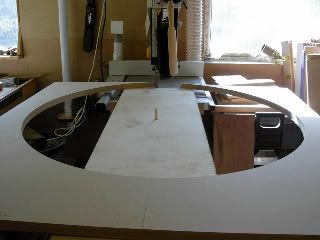
Please bear in mind this photo was taken as a mock-up for this post only normally the blade height would not be set that high up when in use. Now repeat again for the second circle.
2nd JIG.
OK again just scrap wood, In this case, I used hardboard only because that’s all I had.
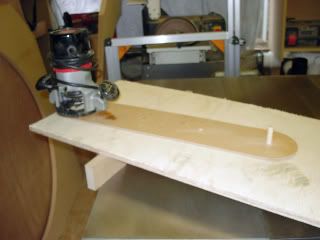
Remember this Photo is also a mock-up for this thread only. Here I’m sorry you have to use your imagination that the circle of MDF is there the swivel dowel is in the inner hole to cut the inside groove for the ball bearings, the other hole you see if for the second groove for the ball bearing. Once you cut the two grooves into both circles you are now ready to start assembling, (but don’t forget to enlarge the centre common hole to take your centre bolt and also cut the hexagon bolt head into the underside of the bottom circle), do that and then secure bottom circle to the workshop floor (hope your floor is level) if not you know what to do.
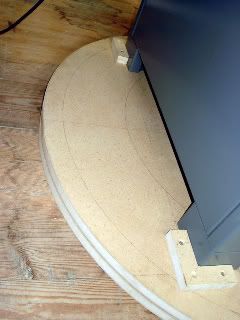 OK so now the bottom circle is secured to the floor, I used 12.7mm ball bearing with the grooves cut to about 5.5mm in-depth on both circles this left a space between the two surfaces of about nearly 2mm ( now you need a 2mm washer to slip it over the centre bolt roll all ball bearing into the grooves, I bought 250 in all which, to be honest, was not quite enough, so buy about 300 in all this should leave just a few over, but don’t do what happened to me when opening the box the inner plastic bag split open and yes all over the workshop floor, oh bugger it took hour finding them all, What joy. Now slip on the top circle and the set of grooves will mate up with the ball bearing and gently tighten down the centre bolt, there you go it’s ready to lift and position your saw to it.
OK so now the bottom circle is secured to the floor, I used 12.7mm ball bearing with the grooves cut to about 5.5mm in-depth on both circles this left a space between the two surfaces of about nearly 2mm ( now you need a 2mm washer to slip it over the centre bolt roll all ball bearing into the grooves, I bought 250 in all which, to be honest, was not quite enough, so buy about 300 in all this should leave just a few over, but don’t do what happened to me when opening the box the inner plastic bag split open and yes all over the workshop floor, oh bugger it took hour finding them all, What joy. Now slip on the top circle and the set of grooves will mate up with the ball bearing and gently tighten down the centre bolt, there you go it’s ready to lift and position your saw to it. This shows the legs of saw sat between the two ball bearing grooves finally the turntable still not yet finished or secure more to follow as soon as possible.
 One of the reasons it's taken some time to finish is now it's mounted on the turntable as seen opposite and is when I turn the saw I wanted the extraction to turn with it which it now does only a few minor things to finish to get it completed, things like a couple of fittings to reduce down from one pipe size to another size on the extraction, I order a couple of roller ball bearings as well, oh and apply a second coat of wax to the machine beds as well.
One of the reasons it's taken some time to finish is now it's mounted on the turntable as seen opposite and is when I turn the saw I wanted the extraction to turn with it which it now does only a few minor things to finish to get it completed, things like a couple of fittings to reduce down from one pipe size to another size on the extraction, I order a couple of roller ball bearings as well, oh and apply a second coat of wax to the machine beds as well.This photo show saw in its normal position facing across the workshop with overhead extraction
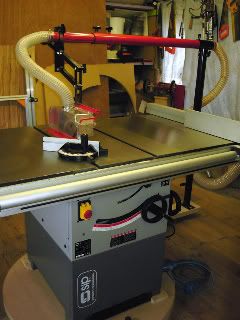 Photo show saw turned 40 degrees to the right so if I want to cut a long length of timber open the workshop door and feed timber out through the opening
Photo show saw turned 40 degrees to the right so if I want to cut a long length of timber open the workshop door and feed timber out through the opening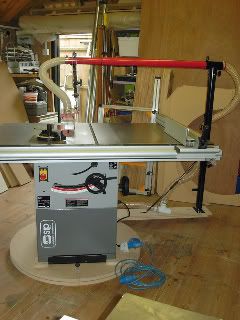 This photo shows missing connection and the arm that supports the overhead extraction piping which is screwed to the turntable, directly under the stanchion poll I fixed an old chair caster (temp) two new roller balls bearings were ordered today to go under there so when turned it just swing round with the saw.
This photo shows missing connection and the arm that supports the overhead extraction piping which is screwed to the turntable, directly under the stanchion poll I fixed an old chair caster (temp) two new roller balls bearings were ordered today to go under there so when turned it just swing round with the saw.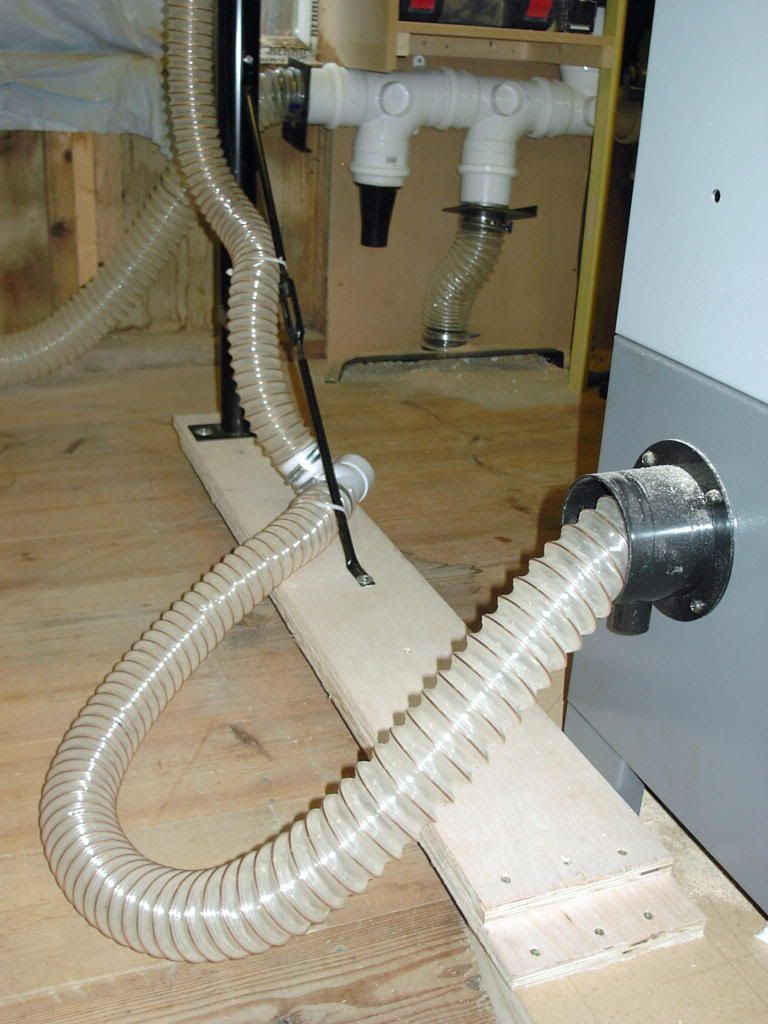 This one showing electrics, plugs at both end, so I can disconnect whichever end I like and it moves around with the turntable
This one showing electrics, plugs at both end, so I can disconnect whichever end I like and it moves around with the turntable 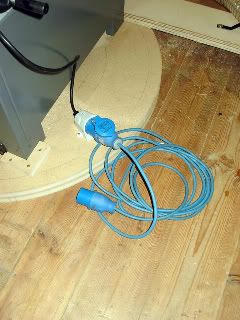
last photo showing locking bolt turntable now has been pre drilled degree holes all I need to do is pull the bolt and with one finger push and the saw glides around to where I want to position it.
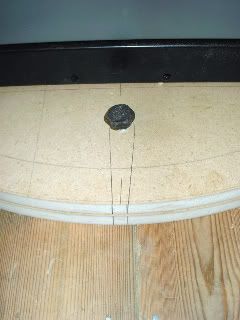 I know my life is much easier now with this turntable no more struggling to move the saw when it in the way just turn it in a jiff for that I have to thank Wellswood over on the UK who did a thread on his turntable.
I know my life is much easier now with this turntable no more struggling to move the saw when it in the way just turn it in a jiff for that I have to thank Wellswood over on the UK who did a thread on his turntable.
No comments:
Post a Comment